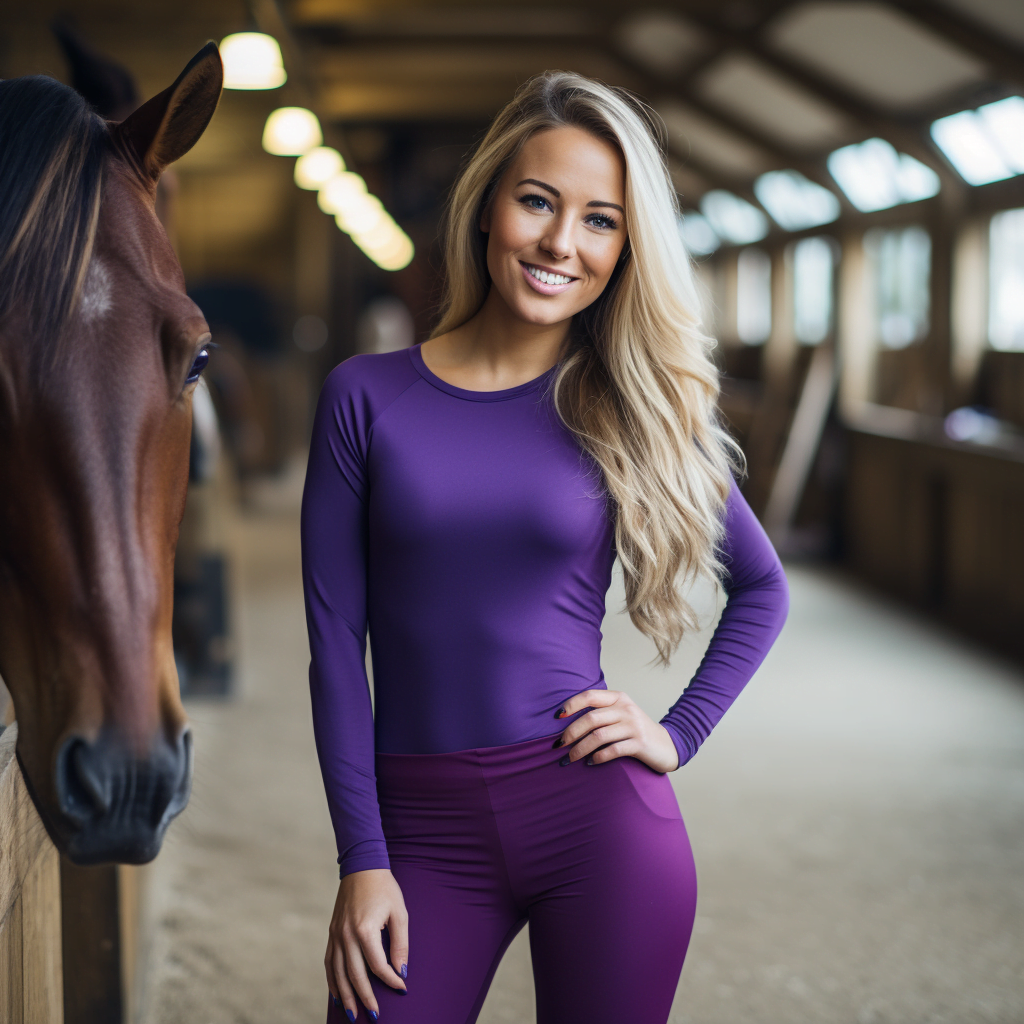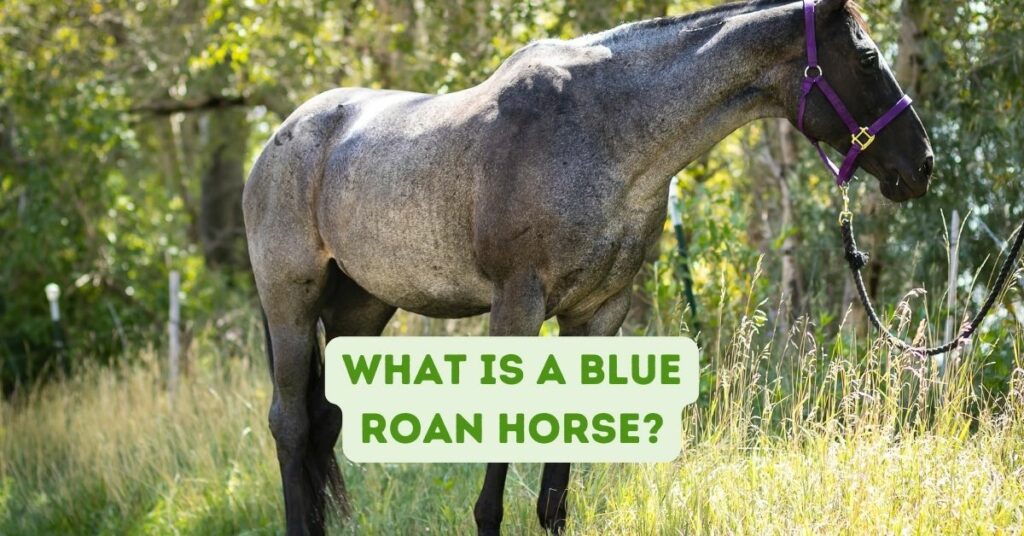As an Amazon Associate we earn from qualifying purchases.
In the realm of equine wonders, few sights captivate the beholder more than the majestic presence of a blue roan horse. This captivating creature boasts a coat that seemingly shimmers with shades of blue, prompting historical associations with mythical beings.
A blue roan horse is a specific coat color variation that results from a genetic combination of black and white hairs. The term “roan” refers to the intermingling of colored and white hairs throughout the coat, creating a speckled or mottled appearance. In the case of a blue roan, the base color is black, and the interspersed white hairs give the coat a bluish tint, although the horse is not truly blue. The blending of these hairs often creates a striking and unique pattern, with the darker and lighter shades producing a visually appealing effect. Blue roan horses can be found in various breeds and are prized for their distinctive coloring, which sets them apart from other coat variations. Another beautiful roan of horse is the red roan horse.
Decoding the Blue Roan Horse Phenomenon
A blue roan horse possesses a distinctive coat color, creating an illusion of blue. The base color is black, intricately interwoven with a roan pattern—a blend of evenly distributed white hairs across the body. Notably, the head maintains a darker hue, while the mane, tail, and specific points of the horse remain solid black.
Roan horses, although diverse in colors, share a common roaning pattern. Unlike a specific breed or coat color, roan denotes a unique coat pattern characterized by scattered white hair flecks, resembling a frosty appearance. The mane, tail, and specific points retain a solid color, while the rest of the body showcases the distinctive white strands.
Blue Roan Horses in Competitions
The show ring often sees the captivating presence of blue roan horses, where their unique coat and graceful movements leave spectators in awe. Learn about their participation in various competitions, showcasing not only their beauty but also their agility and charisma.
Where To Buy Blue Roan Horses
ehorses.com is the best place to buy blue roan horses online.
A blue roan horse is a specific coat color variation that results from a genetic combination of black and white hairs. The term “roan” refers to the intermingling of colored and white hairs throughout the coat, creating a speckled or mottled appearance. In the case of a blue roan, the base color is black, and the interspersed white hairs give the coat a bluish tint, although the horse is not truly blue. The blending of these hairs often creates a striking and unique pattern, with the darker and lighter shades producing a visually appealing effect. Blue roan horses can be found in various breeds and are prized for their distinctive coloring, which sets them apart from other coat variations.
Blue Roan Horses Across Breeds
While the blue roan is not confined to a specific breed, it manifests in various horse breeds, each contributing to the tapestry of equine diversity. Here’s a glimpse into some breeds where the blue roan graces the equine landscape:
| Breed | Description |
|---|---|
| American Paint | Known for vibrant coat patterns, the American Paint breed embraces blue roan as an accepted color variant. |
| Appaloosa | Recognized for distinctive spots, the Appaloosa breed also hosts blue roan individuals within its ranks. |
| Belgian | Although less common, blue roan can be found among Belgians—a robust draft horse breed. |
| Clydesdale | Another draft breed, Clydesdales occasionally showcase the elegance of blue roan, adding a touch of rarity to their powerful stature. |
| Kentucky Mountain Horse | This gaited breed, known for versatility, can exhibit the allure of blue roan in its coat color. |
| Mustang | Symbolizing the American West, Mustangs, including the blue roan variant, embody hardiness and diverse colors. |
| Shire | A large draft horse breed, Shires sporadically exhibit the enchanting blue roan color, albeit less frequently. |
| Standardbred | Predominantly used in harness racing, the Standardbred breed occasionally features the distinctive blue roan color, albeit less commonly than in Quarter Horses. |
| Nakota Horse | Unique to the Great Plains region, Nakota Horses predominantly come in blue roan, celebrated for their medium size, hardiness, and intelligence. |
| Percheron | Originating in France, Percherons, recognized for their muscular stature and versatility, can boast the captivating blue roan coat. |
| Welsh Pony | Known for versatility, Welsh Ponies are more prone to exhibit blue roan, showcasing an excellent temperament in addition to their striking color. |
| Tennessee Walking Horse | Renowned for a distinct gait, Tennessee Walking Horses commonly feature blue roan coats, blending stamina with the allure of this unique color. |
| Hackney | Acknowledged for high-stepping action, Hackneys can also present the captivating blue roan color, contributing to their desirability as driving horses. |
| Morgan | One of the earliest American breeds, Morgans can display blue roan coats, boasting versatility across various disciplines. |
| Paso Fino | Originating in Puerto Rico, the Paso Fino breed embraces blue roan as a recognized color, reflecting its popularity across America. |
| Shetland Pony | Famed for strength and hardiness, Shetland Ponies, including the blue roan variant, make delightful companions for children due to their calm and affectionate nature. |
The Blue Roan Quarter Horse
The blue roan is particularly prevalent among breeds originating in North America, notably the American Quarter Horse. Bred for power and endurance, these horses have left an indelible mark on working ranches, rodeos, and barrel racing circuits.
Several notable blue roan Quarter Horses have emerged over the years, showcasing exceptional talent in their roles and passing on these traits, along with the captivating color, to their progeny. The American Quarter Horse Association officially recognizes blue roan as a distinct color within the breed.
The Blue Roan Standardbred
The Standardbred, primarily associated with harness racing, also carries the blue roan color, albeit less frequently than in its Quarter Horse counterpart. Originating in North America, the breed’s roots trace back to Thoroughbreds, Morgans, and Hackney horses, potentially influencing the evolution of the blue roan gene.
Despite their racing background, Standardbreds are known for their calm demeanor and athletic abilities, making them suitable for diverse equestrian pursuits.
The Blue Roan Nakota
Nakota Horses stand out as a distinctive breed renowned for their striking blue roan coloring. Originating in the Great Plains region of North America, these medium-sized, hardy horses served Native Americans in hunting and warfare, covering vast distances with agility.
Beyond their historical roles, Nakota Horses continue to showcase versatility in modern times, serving as riding companions, pack animals, and even participants in racing events. Their intelligence and ease of training further enhance their appeal.
The Blue Roan Percheron
The Percheron, a draught horse breed with origins in France, adds its own touch to the blue roan spectrum. Tracing back to around AD 800, these muscular and versatile horses were employed by the British Army during World War I.
The Percheron’s distinctive blue roan coat exemplifies the breed’s combination of strength, good temperament, and adaptability.
The Blue Roan Welsh Pony
Welsh Ponies and Cobs, originating in Wales, stand out for their affinity for the blue roan color. Dating back to 1600 BC, these ponies have evolved through influences from Morgan and Hackney horses.
Renowned for their versatility, Welsh Ponies and Cobs cater to riders of all ages. From pit ponies and farm work to show rings and riding companionship, their excellent temperament shines through.
The Blue Roan Tennessee Walking Horse
The Tennessee Walking Horse, famed for its distinctive four-beat lateral ambling style, commonly boasts a blue roan coat. Beyond its unique gait, the breed’s powerful conformation and sweet disposition make it a sought-after choice for riders of all skill levels.
The Blue Roan Hackney Horse
With roots in the United Kingdom, Hackneys showcase high-stepping action and are renowned as excellent driving horses. The blue roan variety adds an extra layer of elegance to their striking appearance, contributing to their popularity in carriage driving and competitive driving events.
Names for Blue Roan Horses
Blue Roan horses are known for their stunning coat color, a captivating blend of black and white hairs that create a mesmerizing blue hue. If you’re lucky enough to have one of these beautiful equines in your stable, finding the perfect name that complements their distinctive appearance is essential. In this article, we’ll explore a curated list of names tailored for Blue Roan horses, ensuring your majestic companion stands out in style.
- Blue Symphony
- Midnight Mirage
- Azure Sky
- Cobalt Breeze
- Onyx Thunder
- Steel Tempest
- Royal Sapphire
- Elegant Noir
- Frosted Moonlight
- Bluebell Dreamer
- Celestial Serenade
- Stormy Horizon
- Whispering Shadows
- Velvet Twilight
- Sapphire Starlight
- Mystic Moonshine
- Enchanting Echo
- Sterling Serenity
- Lapis Lazuli
- Harmony’s Haven
Frequently Asked Blue Roan Horse Questions
Q: Are blue roan horses a specific breed? A: No, blue roan is a coat color found in various horse breeds, and it is not specific to a single breed.
Q: How is the blue roan coat different from other roan variations? A: The blue roan coat is characterized by a mix of black and white hairs, creating a distinct, shimmering effect compared to other roan variations.
Q: Are blue roan horses prone to any health issues related to their coat color? A: No, the blue roan coat color itself does not pose any specific health risks; these horses are generally as healthy as others of their respective breeds.
Q: Can blue roan horses be registered for competitions? A: Yes, many equestrian organizations recognize and register blue roan horses for various competitions, acknowledging their unique beauty and capabilities.
Q: Do blue roan horses require special grooming due to their coat color? A: While they don’t need special grooming, regular care and maintenance are essential to keep their coat healthy and vibrant.
Q: Are blue roan horses rare? A: Blue roan horses are relatively less common than solid-coloured horses, adding to their allure and desirability among horse enthusiasts.
Blue Roan Horses – Final Thoughts
In conclusion, the blue roan horse, with its captivating coat color and diverse representation across breeds, stands as a testament to the allure of equine beauty. Whether galloping across open fields, participating in competitive events, or serving as cherished companions, blue roan horses embody a unique blend of power, grace, and rare aesthetic appeal. Their presence continues to enchant equestrians and horse enthusiasts alike, perpetuating the legacy of this mesmerizing coat color for generations to come.
Amazon and the Amazon logo are trademarks of Amazon.com, Inc, or its affiliates.

Hey there, I’m Jasmine! I’m a total horse fanatic and have been working with these amazing animals for as long as I can remember. I’m passionate about sharing my love for horses with others and helping them learn more about these majestic creatures. As a professional horse trainer and riding instructor, I’ve developed a deep understanding of equine science and am committed to the welfare of horses. That’s why I founded OwnTheHorse.com, a blog where I share my knowledge and insights with fellow horse enthusiasts. I love connecting with my readers and building a friendly community of horse lovers. Whether you’re a seasoned equestrian or just starting out, I’m here to help and inspire you. Above all, I’m a friendly and compassionate person who truly cares about the well-being of horses and their human companions.

